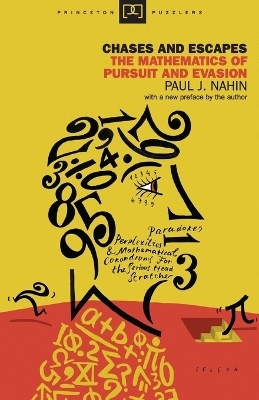
Chases and Escapes
Princeton University Press (Verlag)
978-0-691-15501-2 (ISBN)
We all played tag when we were kids. What most of us don't realize is that this simple chase game is in fact an application of pursuit theory, and that the same principles of games like tag, dodgeball, and hide-and-seek are also at play in military strategy, high-seas chases by the Coast Guard, and even romantic pursuits. In Chases and Escapes, Paul Nahin gives us the first complete history of this fascinating area of mathematics, from its classical analytical beginnings to the present day. Drawing on game theory, geometry, linear algebra, target-tracking algorithms, and much more, Nahin also offers an array of challenging puzzles with their historical background and broader applications. Chases and Escapes includes solutions to all problems and provides computer programs that readers can use for their own cutting-edge analysis. Now with a gripping new preface on how the Enola Gay escaped the shock wave from the atomic bomb dropped on Hiroshima, this book will appeal to anyone interested in the mathematics that underlie pursuit and evasion.
Paul J. Nahin is the best-selling author of many popular math books, including Mrs. Perkins's Electric Quilt, Digital Dice, Dr. Euler's Fabulous Formula, When Least Is Best, and An Imaginary Tale (all Princeton). He is professor emeritus of electrical engineering at the University of New Hampshire.
Preface to the Paperback Edition xiii What You Need to Know to Read This Book (and How I Learned What I Needed to Know to Write It) xxvii Introduction 1 Chapter 1. The Classic Pursuit Problem 7 *1.1 Pierre Bouguer's Pirate Ship Analysis 7 *1.2 A Modern Twist on Bouguer 17 *1.3 Before Bouguer: The Tractrix 23 *1.4 The Myth of Leonardo da Vinci 27 *1.5 Apollonius Pursuit and Ramchundra's Intercept Problem 29 Chapter 2. Pursuit of (Mostly) Maneuvering Targets 41 *2.1 Hathaway's Dog-and-Duck Circular Pursuit Problem 41 *2.2 Computer Solution of Hathaway's Pursuit Problem 52 *2.3 Velocity and Acceleration Calculations for a Moving Body 64 *2.4 Houghton's Problem: A Circular Pursuit That Is Solvable in Closed Form 78 *2.5 Pursuit of Invisible Targets 85 *2.6 Proportional Navigation 93 Chapter 3. Cyclic Pursuit 106 *3.1 A Brief History of the n-Bug Problem, and Why It Is of Practical Interest 106 *3.2 The Symmetrical n-Bug Problem 110 *3.3 Morley's Nonsymmetrical 3-Bug Problem 116 Chapter 4. Seven Classic Evasion Problems 128 *4.1 The Lady-in-the-Lake Problem 128 *4.2 Isaacs's Guarding-the-Target Problem 138 *4.3 The Hiding Path Problem 143 *4.4 The Hidden Object Problem: Pursuit and Evasion as a Simple Two-Person, Zero-Sum Game of Attack-and-Defend 156 *4.5 The Discrete Search Game for a Stationary Evader -- Hunting for Hiding Submarines 168 *4.6 A Discrete Search Game with a Mobile Evader -- Isaacs's Princess-and-Monster Problem 174 *4.7 Rado's Lion-and-Man Problem and Besicovitch's Astonishing Solution 181 Appendix A Solution to the Challenge Problems of Section 1.1 187 Appendix B Solutions to the Challenge Problems of Section 1.2 190 Appendix C Solution to the Challenge Problem of Section 1.5 198 Appendix D Solution to the Challenge Problem of Section 2.2 202 Appendix E Solution to the Challenge Problem of Section 2.3 209 Appendix F Solution to the Challenge Problem of Section 2.5 214 Appendix G Solution to the Challenge Problem of Section 3.2 217 Appendix H Solution to the Challenge Problem of Section 4.3 219 Appendix I Solution to the Challenge Problem of Section 4.4 222 Appendix J Solution to the Challenge Problem of Section 4.7 224 Appendix K Guelman's Proof 229 Notes 235 Bibliography 245 Acknowledgments 249 Index 251
| Erscheint lt. Verlag | 22.7.2012 |
|---|---|
| Reihe/Serie | Princeton Puzzlers |
| Zusatzinfo | 5 halftones. 67 line illus. |
| Verlagsort | New Jersey |
| Sprache | englisch |
| Maße | 140 x 216 mm |
| Gewicht | 255 g |
| Themenwelt | Sachbuch/Ratgeber ► Natur / Technik |
| Mathematik / Informatik ► Mathematik ► Allgemeines / Lexika | |
| Mathematik / Informatik ► Mathematik ► Angewandte Mathematik | |
| Mathematik / Informatik ► Mathematik ► Finanz- / Wirtschaftsmathematik | |
| Mathematik / Informatik ► Mathematik ► Geschichte der Mathematik | |
| Mathematik / Informatik ► Mathematik ► Mathematische Spiele und Unterhaltung | |
| ISBN-10 | 0-691-15501-1 / 0691155011 |
| ISBN-13 | 978-0-691-15501-2 / 9780691155012 |
| Zustand | Neuware |
| Haben Sie eine Frage zum Produkt? |
aus dem Bereich


